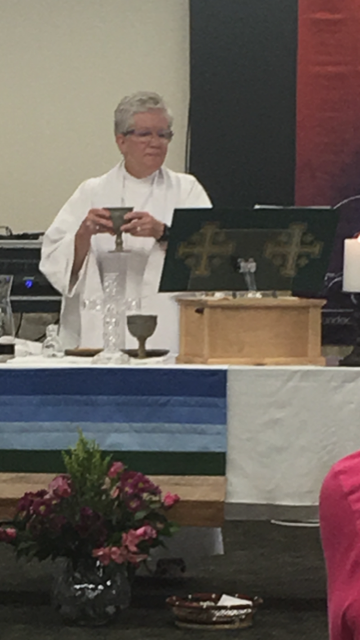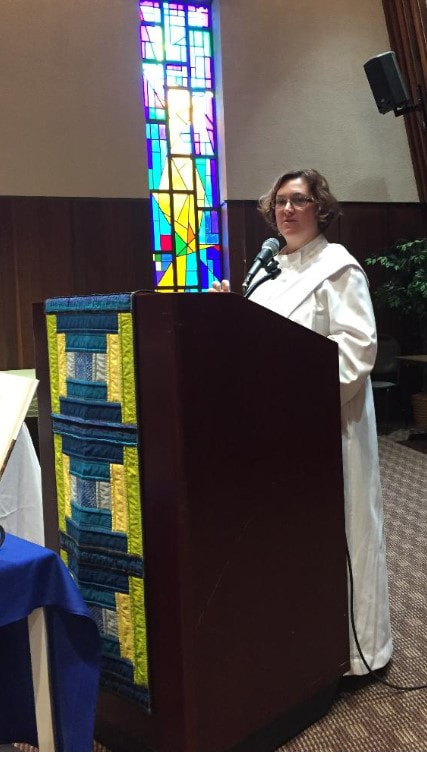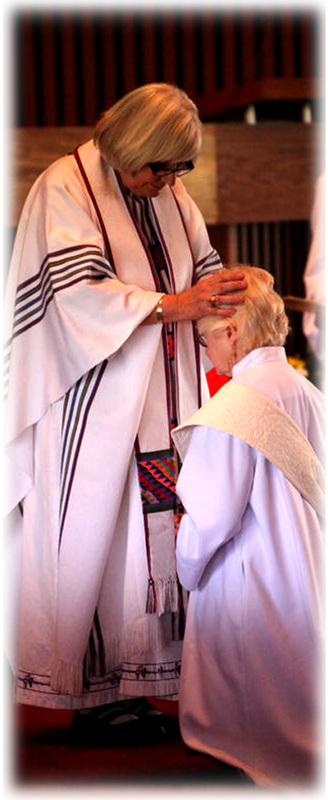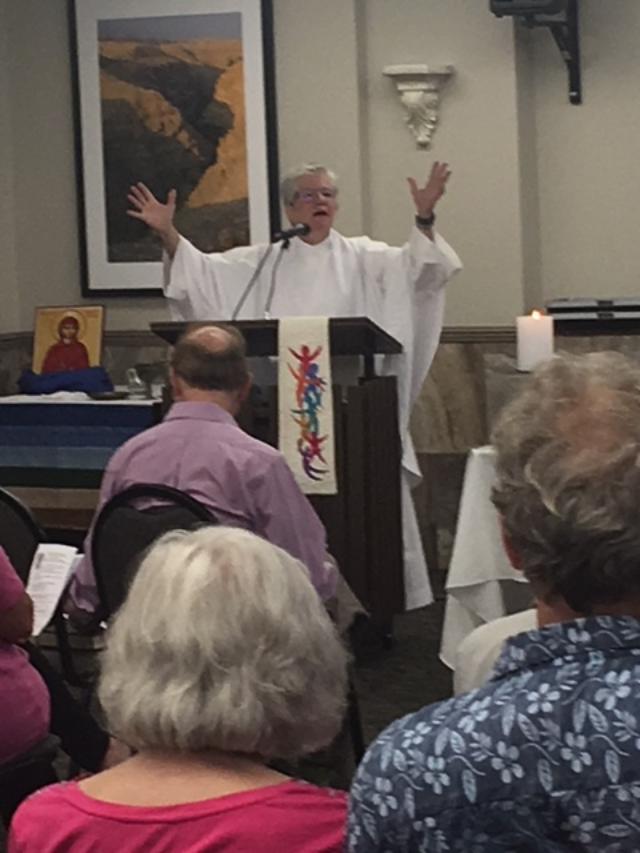Homily
Six weeks ago I took vows for the first time as a Sister of Providence. I committed to live out poverty, chastity and obedience with the support of my community. In preparation for professing these three big scary words in front of hundreds of people, I engaged in study and conversation with my Sisters to deepen my understanding of exactly what I was getting myself into. When asked by my director which of the vows I imagined I’d find most difficult, I answered without hesitation: OBEDIENCE. Those who know me may not be surprised by this. I’ve never been big on doing things just because someone told me to…my parents, teachers and formators can affirm this. I always wanted to know WHY…what was the reasoning behind a request – who would benefit?...What would be the impact of following given directions? My stomach turned when I thought about publicly promising to be obedient to anyone.
So, I was surprised when the reading assigned on obedience spoke to my heart most of all. Sandra Schneiders, in her book Buying the Field laid out a description of what it meant to live PROPHETIC OBEDIENCE – an alternate approach to freedom and power. At first glance the words seemed opposed – how could someone be prophetic and obedient at the same time? But when we consider that the root of the word “obey” actually means to listen, hear or perceive, and that the word “prophet” means hearer or interpreter, the connection seems obvious. Prophetic obedience is not a contradiction at all – one word actually reinforces the other. The woman prophets we heard about today lives out deep and sometimes unfathomable contradictions. This is precisely what makes them prophet material. I want to explore with you this role of prophet, drawing heavily from Sandra Schneiders’ writings, how we see it in these Biblical women and in women prophets today in our own city.
One contradiction we see is that a prophet’s reality is both deeply connected and marginalized at the same time. A prophet is…
- Deeply connected to the current reality, to the signs of the times, but marginalized by corrupt powers-that-be who have shaped that reality.
- Profoundly in tune with the mind of God while tuning out the mind of the oppressor.
- Shares the experience and culture of the enslaved while she is often mocked by those inside the circle of influence, the dominant culture.
- We see this in the experience of Miriam – she herself has lived the life of a slave…her song of praise comes from a place of connectedness to the pain of her people...she knows the shame of hiding her brother among the reeds on the banks of the river…she is connected to a reality that excludes her brother’s life from the circle of concern and labels him disposable/expendible from the empire’s point of view… and from this same place of pain she knows what it will mean for them to be liberated.
- We see this same tension of connection and marginalization in the Samaritan woman at the well. This woman, who has chosen to approach the well at high noon when she could be sure no one else would be around, had been sent a clear message in her life that she does not fit within the acceptable bounds of the dominant culture. And yet, when Jesus chooses to see her, the woman’s response is to seek connection…to move beyond the mind of the oppressor and share her own truth with everyone in town. This woman prophet’s truth comes directly from her experience of both marginalization and connection.
- I won’t share her name, but the woman speaking in this picture is a prophet I have known this year…When she spoke at our May 1 rally, she proclaimed to hundreds of people that she had been living with an order of deportation for four years. The next day, she would go to her ICE check-in in Chicago. This woman prophet continues to be marginalized by the dominant culture – tells her she does not deserve to be here…the empire forces her to live in a painful place of not knowing whether she’ll be forced to return to El Salvador where she was daily extorted by gangs on her walk to work…And yet her connectedness to this experience, to a broader group of people who have been called unworthy, labeled criminals, gives her the strength to share her story.
- Crystal, an IndyCAN leader, is another prophet I’ve come to know. From the time her son entered school, he has been singled out, punished, labeled for things as simple as asking too many questions. His teachers and administrators have marginalized him to the point of asking his mother put him on medication when similar behaviors in white students were unnoticed or dismissed. This woman prophet chose to keep her son in public school and fight for him, knowing that other students experienced the same struggle that demanded change. She chose deeper connection that would lead to understanding and transformation even as efforts to marginalize her son continued for 14 years. He’ll graduate from high school this year. J
- Another woman prophet in this photo will go unnamed, in solidarity with the many woman prophets in our scriptures who are unnamed. She carries the pain and juxtaposition of connection and marginalization within her. At 8 months pregnant, this woman came into a room with the Mayor’s lawyer to share that she carried within her a child whose fate was uncertain because the city had chosen to continue cooperating with ICE. It doesn’t get much more connected than that. Her testimony leaped the chasm of marginalization and forced the empire to face a connection with the truth.
These and other women prophets occupy a stressful and conflict-ridden space: deep connection and isolation.
Women prophets also hold a tension in their message: they speak truth to power and hope to the oppressed. Hard truth and joyful hope; lament for the way things are and energy for the way they can be.
- We see this message in Elizabeth. Elizabeth spent years mourning her inability to conceive a child. When she encountered Mary, she must have carried the heaviness of fear, knowing the danger of bearing a child late in life, and knowing that Mary would face discrimination and the threat of real violence as an unwed mother in her culture. Yet these imminent threats – the reality before her – did not prevent Elizabeth from responding to the joy these possibilities of new life stirred in her. As her mind surely swirled with heavy questions, hope won over her words: “Blessed are you who believed that what was spoken to you by God would be fulfilled.”
- The prophet Anna spent years on the lament side of things. Tradition says she fasted and prayed in the temple for years, yearning for one who would come to liberate the working class poor from the Roman empire. When she finally met the child Jesus, she quickly moved into a real, tangible hope for her oppressed people – as the reading we heard today says, “she preached the miracle made flesh, Whom her own eyes had seen.”
- And certainly the tension of lament and hope is present in the witness of our own Apostle to the Apostles, Mary of Magdala. Mary, with the other followers of Jesus, had just endured the public condemnation of one of her dearest friends and mentors, who was finally sentenced to death by the empire. She came to the temple full of lament. Yet there must have been some spark of hope in her, or she would not have continued to seek connection with Jesus. Her pain increased as she discovered even her beloved Rabbi’s body had been taken away. What did she have left of this man who represented hope to her that her people could escape from under the thumb of an oppressive regime? Through tears, she laments to the angels, “they have taken away my Rabbi, and I don’t know where they have put the body.” Her perseverance in presence is rewarded when she encounters Jesus himself. After exchanging words with her teacher, Mary cannot contain her message of hope. She runs to the disciples proclaiming, “I HAVE SEEN THE TEACHER!”
- In a similar way, I celebrate the woman prophet Olga. Pictured here, she has seen her brother detained for a month in the Hamilton Co. prison for driving while brown. Another brother’s job choices are limited to places on the bus routes because of his fear of driving without a license. Last fall, Olga lamented the fear of her immigrant brothers and sisters – her own family – to the powers that be: to Senators Donnelly and Young. In February, she asked the mayor to pledge that not one dime of city resources would be spent on discriminatory or unconstitutional policies. Her willingness to ask for change speaks to a hope that things can be different. And we celebrate with her Sheriff Layton’s choice to end ICE detainers in our local jail.
- We also see woman prophets in these family members of Aaron Bailey, including his daughter Erica Bailey, who lament the death of a man they loved dearly, shot 14 times from behind by police officers even as he was unarmed and had been impacted by a deployed airbag. These women could have chosen to stay out of the public eye, given the fact that time and time again powerful white men have gone free after killing unarmed black men. But they chose to be present and lament the things they would miss about a man who was father and brother and uncle to them. Their presence speaks to a hope and a plea that things might be different.
Hard truth and joyful hope. Lament and possibility. None of these women chose the structures of oppression that would walk them into the role of prophet. Yet, their deep awareness and connectedness to the Spirit led them to be obedient to the signs of the times; to occupy a stressful and conflict-ridden space, knowing deeply that things CAN be different.
We celebrate these women today and many others who go unnamed and unrecognized even as they occupy the space of prophet.
In closing, I want to share my gratitude that today’s collection will go to our Sisters of Providence community. As a true middle class white girl from the suburbs, I’m quite uncomfortable talking about money, but this act of investing resources has a particularly prophetic meaning for me today. I’ll explain why. The day before I took first vows, a member of our Missions Advancement staff informed me that a donor requested to drop their name from our list because they saw me as a political activist. Of course I didn’t get a chance to explain to this person that a community organizer is actually distinctly different from an activist, because I don’t know this person. They had never met me personally. I have had a sense for some time that this day might come, but it still hurt. I still struggled with mixed feelings about how the public aspect of my ministry might impact our religious community. The timing was also not ideal as I was preparing to deepen my commitment the next day. You wanted prophetic obedience? You got it…A couple conversations with my Sisters affirmed that religious life was never created to uphold the status quo, and this was actually a sign that we are right where we need to be. Two days later, I received an email from Maria asking me to speak at this celebration and mentioning that the collection would go to our community. In that series of events, I saw lament move into hope. I saw the mind of the oppressor give way to energy for something new. All that to say: those who give today are participating in a truly prophetic act. And I thank Maria and this community, all women prophets, for reminding us of who we can be.
Collected $522.00 for Sisters of Providence, Terra Haute, IN
Feast of Corpus Christi
Maria Thornton McClain, RCWP
June 18, 2017
The phrase, “flesh and blood” is rich in meaning, especially for families. Think “She is my own flesh and blood.” For Jesus, saying that the bread was his body and the wine his blood was an allusion to his incarnation and looked forward to his death on the cross because of his love for the neediest. Today we remember and focus on his saying, “Do this in memory of me.” We share the ritual meal in which we are nourished by Jesus’ very person. It is in the fullness of life that he gives a participation in God’s own life, endless and complete love.
That ritual meal has gone through various adaptations throughout time. Fifty years ago Pope John XXIII called the 2nd Vatican Council to bring the Catholic Church into better resonance with the realities of the 20th century. The first area that was ready to be dealt with was the liturgy. For more than 50 years before that, first in abbeys, then universities in Europe, there was a great energy and enthusiasm for simplifying the Mass. That movement quickly spread to the United States. People wanted to make that memorial meal clearly recognizable and filled with the power of Jesus’ intimate love for his followers.
The sound theological principles of the reform of the liturgy of the Mass and sacraments focused on the Church as the People of God. In other words, the Church is not just the clergy. All baptized persons are part of the Body of Christ and are called to give the complete gift of themselves to God for the benefit of all and especially the neediest.
I encourage all of us who are used to saying “The Church teaches, says, etc.” to change it to “The bishops say, etc.” to get away from that attitude that “The Church” equals the official authorities only, and not all of us. We are the people of God.
The Constitution on the Sacred Liturgy states that everyone is to actively participate in the rites of the Mass. The Mass had gotten overlaid with extra ceremonies and elaborations that obscured what Jesus was really expressing through his command to the group gathered with him. He told them to eat his flesh and drink his blood, meaning to become mirror images of him. His followers, as a whole people, were to become him, alive throughout time and place, giving their lives, as he did, so that all people could have the fullness of life and love.
That leads to the question, “How do we best do that in our time and place?” Much of that is for this community to answer for ourselves. We are a community founded by a woman preparing to be a Roman Catholic Womanpriest and the people who supported her in that endeavor. Their goal was to establish a Roman Catholic worshipping community. That meant it was to be a community that followed the principles of Vatican II without the restraints of past embellishments of the liturgy that do not express the needs of our time. That was seven years ago. We are those people and those who later joined us. How do we continuously become more “grounded in tradition, and soaring with the Spirit?”
A group of RCWP leaders recently answered the question, “What does a liturgy need in order to be considered Catholic and Eucharistic?” Some of the answers offered can be helpful to us as we strive to express our faith in a way that is faithful to what Jesus was asking his followers to do and ritualize. For example:
- The intention of those who gather is to remember what Jesus taught and what is expected of his followers.
- All are welcomed at the table.
- Those present exercise their common priesthood in the celebration.
- The service includes a Liturgy of the Word, made up of scripture and other inspirational readings.
- It includes a Liturgy of the Eucharist, where bread and wine are offered, blessed, broken and shared. The people gathered are the Body of Christ and go out into the world as such.



 RSS Feed
RSS Feed

